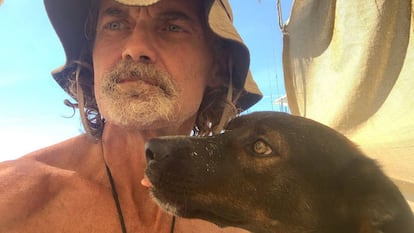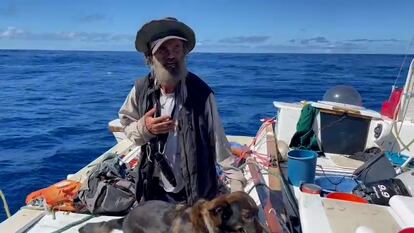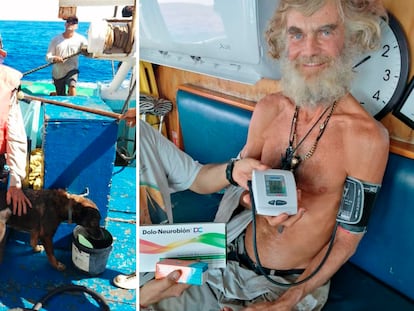A helicopter, a harpoon and a ‘bohemian’ adrift: the rescue of Australian castaway Tim Shaddock
EL PAÍS reconstructs the rescue of the veteran sailor, who was stranded for months in the Eastern Pacific, based on interviews with the members of the crew that saved him
A helicopter flies over the waters of the Eastern Pacific. It scans the blue surface of the ocean, on the trail of a moving black spot that reveals the position of a school of tuna. The operation follows the same roadmap of the past two months: the aircraft finds the fish, alerts the crew of the María Delia and the vessel sets course for the location. On July 12, however, something unusual happened. From the air, the pilots spotted a small white catamaran, with a mast but no sails. There was no movement on deck. A man looked up at the sky, covering his face, dazzled by the sun, signaling for help.
Immediately, the helicopter pilots contacted the María Delia. The ship hurried to the location. A boatload of sailors approached the catamaran, circling the vessel several times to make sure there was no danger. The man and a dog approached the side. He was wearing a brown vest and a shirt that was had been, once, white. On his head, he sported a hat on top of a cap.
“Do you speak English,” one of the crew asked him. “Yes sir, thank you,” the man replied as he held his hands to his chest. “Are you OK?” “Thank you,” the man repeated. “We need to know if you have any drugs or weapons aboard,” the crewman stated. “No, I don’t have any drugs or weapons,” the man replied. “Are you sure?” “Yes, you can check anything you like. I’ve been fishing here, surviving.”

A storm, raw fish and ducks
The last time Tim Shaddock, a 54-year-old Australian, had seen land before Tuesday was in the Sea of Cortez under a full moon in early May. He had set sail aboard his small white catamaran, the Aloha Toa, from the port of La Paz, in Baja California Sur, western Mexico. His only companion is Bella, a dog he adopted some time ago. The sailors on the María Delia are the first sign of human life the odd couple has seen in three months.
Shaddock is dazed, confused. He’s still not quite sure what’s happening, but he can’t help but be thankful. “[Shaddock was] amazed by our arrival. I feel he felt lost: he turned around, saw us, and his reaction was not even one of emotion,” Orlando Zepeda, one of Shaddock’s rescuers, tells EL PAÍS.
The crew lifts Shaddock onto the lifeboat after searching his vessel and checking that he is not hiding weapons or drugs. He is 1,200 miles (almost 2,000 kilometers) from the Mexican coast, in international waters. For the past three months he and Bella have survived by eating raw fish he hunted with a harpoon, ducks he caught when they landed on the catamaran’s deck and rainwater. The only shelter on the Aloha Toa is a small cabin that provided some shade.
When he finally finds himself safe and sound aboard the María Delia, Shaddock burst into tears. He was dehydrated, malnourished, and showing signs of sunstroke. “His blood pressure was taken and he was fine. He was just lacking food because he had been there for a long time, and little by little he was recovering,” Zepeda says.

Shaddock is an experienced sailor and has traveled extensively in the Aloha Toa. He was attempting to sail to French Polynesia, more than 6,000 kilometers (3,728 miles) across the open sea. But a storm hit. First, it ripped off his sail. Then, the engine stopped working. “Two pieces of bad luck,” says Antonio Suárez, president of Grupomar, the company that owns the María Delia.
Despite his malnourishment, disorientation and bedraggled appearance, the Australian adventurer is doing well. “I’m just so grateful. I’m alive and I didn’t really think I’d make it”
Shaddock said Tuesday when the María Delia docked at the port of Manzanillo, Colima “There were many, many, many bad days and many good days,” he said. “The energy, the fatigue is the hardest part. [In a shipwreck] you’re always fixing something. I was trying to find happiness within myself. And I found it alone, in the sea.”
“A bohemian man, who likes nature”
Shaddock is a singular individual. “A bohemian man, who likes nature,” as Suárez defines him. The Australian was an athlete as a young man and an employee of the multinational technology company IBM. In the 1990s, he was diagnosed with cancer. He started treating himself with conventional medical remedies, but later decided to opt for holistic methods. “Many are surprised at my seemingly opposing passions for technology and that of nature and natural healing. It’s actually all about technology for me, it’s just that nature has profound technology embodied in it when you know how to apply it,” he said in an interview with The Raw Food Kitchen magazine in 2013.
Trips like the one he attempted to French Polynesia are a regular occurrence in Shaddock’s life, although there is no record of him having suffered any similar accidents previously. His shipwreck is “a very exceptional and very strange case,” says Suárez. However, this is not the first time that one of Grupomar’s boats has found a vessel adrift. “In the years that I have been in tuna fishing we have had four or five cases of encountering people with a broken engine, a small yacht with a family aboard...” he explains. Once, one of his boats encountered a missile floating in the middle of the ocean. “Now that was tricky,” he laughs.
Providing assistance to vessels adrift on the high seas is an obligation under the United Nations International Convention on Maritime Search and Rescue. “With tuna fishing you travel many miles, in international waters, and we are aware that we are exposed to encountering single vessels. As a human being, you always approach vessels that you see like this in order to rescue people who may be shipwrecked, it’s the normal thing to do” says Zepeda.
When the María Delia docked at the port of Manzanillo on July 18, the sailors had been at sea for two months. The Australian, for about 90 days. He may not know it yet but his story has captivated the world and major international newspapers are scrambling to get an interview. Suárez, who followed the rescue with the same interest as the media, raced to meet the famous castaway: “I arrived in the morning, went to the boat and met Timothy. He hugged me. He was worried because he had no money and asked how much it was going to cost. ‘Well, nothing, we’re saving you for free,’” says the Grupomar president.
The Australian government, consulted by this newspaper, says that it is providing consular assistance, although it states that due to “privacy obligations” they cannot comment further on the matter. The sailors of the María Delia, meanwhile, are toasting the rescue. Suárez invited the entire crew to lunch and follows news about Shaddock closely. Medical tests on shore confirm that he is doing well. There was also another cause for celebration: under the Australian’s catamaran they found a huge school of tuna. When the rescue operation was complete, the fishing began.
Sign up for our weekly newsletter to get more English-language news coverage from EL PAÍS USA Edition
Tu suscripción se está usando en otro dispositivo
¿Quieres añadir otro usuario a tu suscripción?
Si continúas leyendo en este dispositivo, no se podrá leer en el otro.
FlechaTu suscripción se está usando en otro dispositivo y solo puedes acceder a EL PAÍS desde un dispositivo a la vez.
Si quieres compartir tu cuenta, cambia tu suscripción a la modalidad Premium, así podrás añadir otro usuario. Cada uno accederá con su propia cuenta de email, lo que os permitirá personalizar vuestra experiencia en EL PAÍS.
¿Tienes una suscripción de empresa? Accede aquí para contratar más cuentas.
En el caso de no saber quién está usando tu cuenta, te recomendamos cambiar tu contraseña aquí.
Si decides continuar compartiendo tu cuenta, este mensaje se mostrará en tu dispositivo y en el de la otra persona que está usando tu cuenta de forma indefinida, afectando a tu experiencia de lectura. Puedes consultar aquí los términos y condiciones de la suscripción digital.
More information
Archived In
Últimas noticias
Most viewed
- Sinaloa Cartel war is taking its toll on Los Chapitos
- Oona Chaplin: ‘I told James Cameron that I was living in a treehouse and starting a permaculture project with a friend’
- Reinhard Genzel, Nobel laureate in physics: ‘One-minute videos will never give you the truth’
- Why the price of coffee has skyrocketed: from Brazilian plantations to specialty coffee houses
- Silver prices are going crazy: This is what’s fueling the rally











































